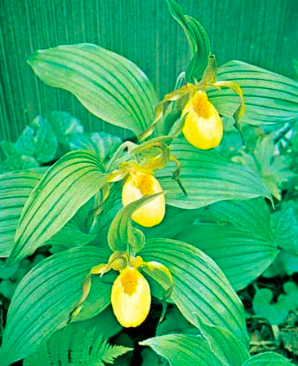Giant Ladyslipper Orchids and more. . .
by Arthur Evans

Mother Nature’s calendar says the first week of May is the time Cypripedium kentuckiense should bloom down in the Ouachita Mountains near Hot Springs. Duly summoned, I tried to raise a posse to make the pilgrimage to see them. Not surprisingly, the heavy rain kept people away in droves. The long drive, rough hike, deep creek crossings, and Somali pirates probably had something to do with it as well. Anyway, I had to go alone. That’s OK , but instead of lively conversation about orchids I listened to a course on CDs from The Teaching Company, Joyce’s Ulysses. I had given up trying to read it straight through.
Access to the orchids involves about half a mile of rough bushwhacking and two creek crossings. The rain had the creek bank full, about waist deep. Good thing my camera case doubles as a personal flotation device. Though the area is known for its large diamondback rattlesnakes, I didn’t see any, but looking carefully at each step through heavy brush makes for slow going.
The site where they grow is pretty unique, an acid-water seep at the base of a ridge in heavy forest. Other rare plants grow there ,too, such as Cranefly orchids, Adam and Eve orchids, Lilium michiganense, American holly, and giant ferns with unpronounceable names (well, maybe Steve Marak could). It rained hard all the way down there and most of the way back, but the rain let up just long enough for me to get some pictures. The giant yellow ladyslippers were in prime condition, no unopened buds and no faded blooms. There were about 20 blooming stems, about half of the normal number. Part of the reason may be that the big ice storm toppled some big trees on the site, some right on top of clumps of orchids. What a tangled mess it was. Oh well, the extra light will be good for the lilies, which have struggled to survive in the deep shade.
Cypripedium kentuckiense is the largest of the three forms of yellow ladyslippers in Arkansas. It is almost twice as large as the mid-sized version, Cyp. parviflorum v. pubescens. The pouch is light creamy yellow, and the petals dark brownish maroon, a striking contrast. Occasionally, a vigorous stem will have two blooms. It is a splendid orchid and well worth the effort to see it in bloom. Now, if I can just find The Queen (Cyp. reginae) , I can die happy.
©Copyright 2023 Art Evans